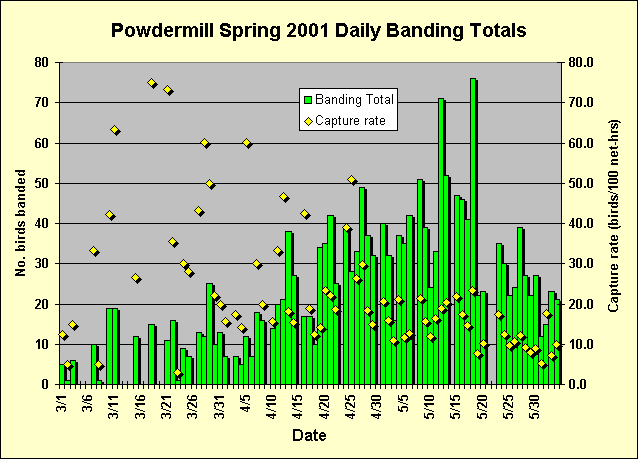
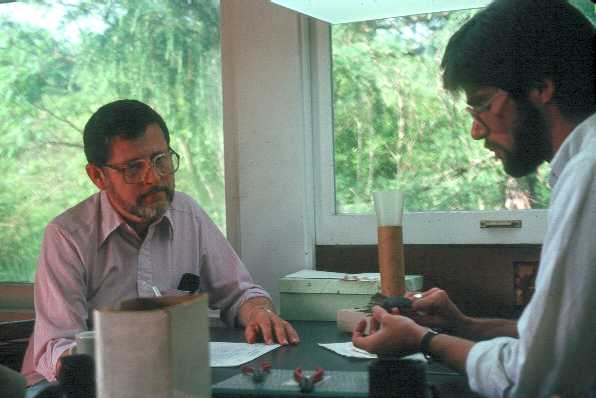 The
bird-banding program at Powdermill Biological Station, run by principal
bander Robert C.
Leberman (left), who began the program in the summer of 1961, and field
ornithologist
Robert
S. Mulvihill (right), who began assisting with the program in 1978,
was in operation on 75 out of a possible 94 days during the spring 2001
period (March through 3 June). A total of 1,819 birds was banded,
and there were an additional 655 recaptures, for a total addition of 2,474
banding records to our database.
The
bird-banding program at Powdermill Biological Station, run by principal
bander Robert C.
Leberman (left), who began the program in the summer of 1961, and field
ornithologist
Robert
S. Mulvihill (right), who began assisting with the program in 1978,
was in operation on 75 out of a possible 94 days during the spring 2001
period (March through 3 June). A total of 1,819 birds was banded,
and there were an additional 655 recaptures, for a total addition of 2,474
banding records to our database.
Although, as expected, we reached our milestone 400,000th original banding record during the season, we ended up the season 676 records shy of achieving a combined total of a half million original banding plus recapture records in our database. We failed to band >100 birds on any day during the season; in fact, we banded >50 birds on just four days. Our busiest days were May 12 (71 birds banded) and May 18 (76 banded). In general, capture rates were much higher early in the season, when we operated many fewer nets and traps and when most of the birds being banded were those concentrated at bird feeders. Capture rates declined from late April through May.

Highlight of the season was our fourth ever Swainson's Warbler. Only our spring 2001 total for Gray Catbird set a new record high total for the season (114 banded). Conspicuous spring "misses" included Yellow-billed Cuckoo, Great Crested Flycatcher, Olive-sided Flycatcher, Palm Warbler, Yellow-breasted Chat, Evening Grosbeak, and House Sparrow.
Our overall spring capture total in 2001 was the third lowest in 40 years, and our spring capture rate (17 birds/100 net-hrs.) may well be the lowest ever (we have not yet completed compiling data for spring banding effort for all years, but we provide them when they become available).
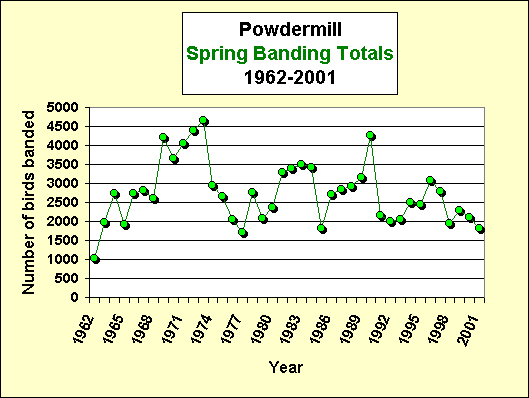
With 104 species or recognizable forms banded, however, the diversity of our catch this spring was above average, helped by the capture of single individuals of 22 species
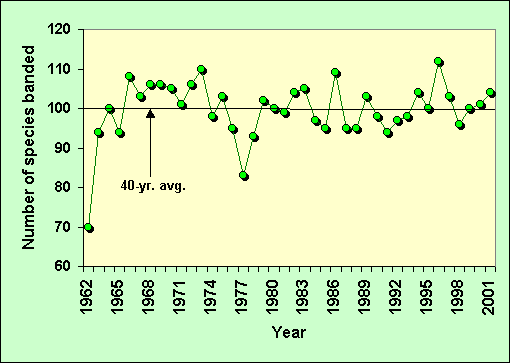
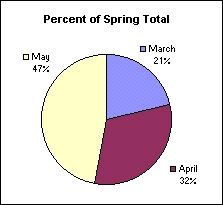 |
|
|
|
|
|
|
At Powdermill, in general, sparrows, northern finches, and blackbirds are better represented in our banding totals (percentage-wise) in spring than fall; the reverse is true for wood warblers, thrushes, and flycatchers.
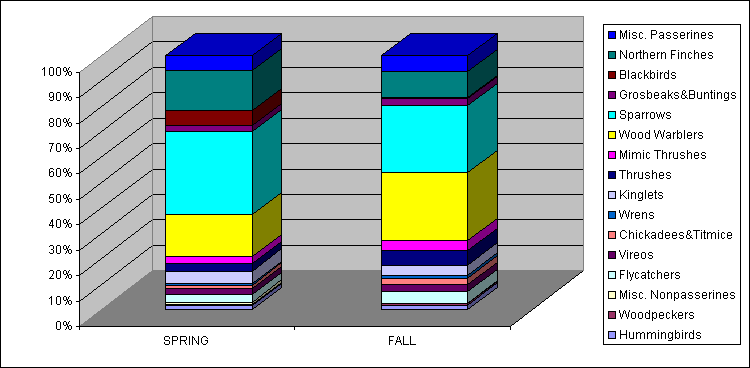
As another way of looking at the spring 2001 Powdermill banding season, when our spring banding totals were broken down taxonomically, the percent contribution for "Sparrows," which includes juncos, was much smaller than usual in spring 2001 (see pie charts). Another pattern evident in these taxonomic pie charts is the much higher percent contribution of "Northern Finches" in the 1970s (Evening Grosbeaks) and 1980s (Pine Siskins), spring flights of which all but disappeared in the most recent decade.
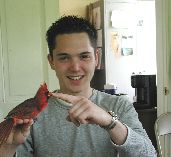
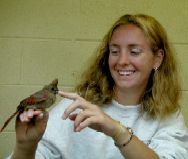
We were fortunate, as always, to have assistance from a number of dedicated volunteers, especially Darlene Madarish, Carole Shanahan, Mary Helen Chiodo, and Carroll Labarthe. Others who assisted from time to time included Powdermill interns Jami Paul, Kerry Keto, and Matt Demarines. And, occasionally, we pressed visitors like Jack and Karyl Merchant and their daughter, Jessica, Bob Shaw, Peggy Wisner, Louise Carroll, Kevin Georg, and Geoff Burtner into service to help carry bags with birds or as record-keepers. Our friend, Don Koch, who has volunteered with us off and on for several years, spent one last day helping with the banding this spring before taking off for a new job in Ohio, the result of a well-deserved promotion. We and the rest of western Pennsylvania's birding and nature-loving community certainly will miss Don, and we hope that he revisits Penn's Woods often. Don embodies the naturalist's curiosity and as a frequent and popular outings leader for the Westmoreland County Bird Club, he generously shared his broad and ever-growing body of knowledge, always with good humor and contagious enthusiasm.
Last, but certainly not least, our good friend and very talented fellow bander, Jim Gruber, gave us the benefit of his energy and banding expertise for a week near the end of our season (and this was on the heels of a very busy season of banding at his own station on the Eastern Shore of Maryland). Thanks, Jim!
Finally, for supporting and facilitating our efforts in many ways beyond direct help with the banding, we thank Powdermill's Director, Dr. Joseph F. Merritt, and the station's maintenance crew, Gilbert and Albert Lenhart and Lloyd Moore. Also, we owe a tremendous debt to our data entry operator at Carnegie Museum's Section of Birds, Marilyn Niedermeier, who painstakingly enters, checks and double checks all of our banding records, and who is responsible for generating banding schedules and fulfilling data requests.
On the following pages, Powdermill banding totals (original captures only) from spring 2001 are compared to averages, maxima, and minima for the previous 39 years, as well as to each of the four individual decades that the banding program has been in operation. For selected species, we have graphed the annual spring totals from 1962-2001, and these are accessible through links in the species totals summary tables.
As with the fall comparisons, to some degree there may appear to be trends in these raw (i.e., uncorrected for effort) spring banding data. It could be argued that the possible ecological or populational significance of these trends is strengthened when they show up in independent data sets (i.e., both spring and fall migration samples). For this reason, we have graphed the spring totals together with the fall totals in this summary. In many cases seasonal patterns are strikingly concordant (e.g., birds possibly declining due to loss of old field habitat at Powdermill due to natural succession: Brown Thrasher, Prairie Warbler, Yellow-breasted Chat, Field Sparrow; birds expanding their range in the Northeast: White-eyed Vireo [subsequently declining somewhat due to habitat loss], Blue-winged Warbler, House Finch [subsequently declining due to natural population dynamics, conjunctivitis, ??]; birds possibly experiencing increasing population trends: Ruby-throated Hummingbird, Chestnut-sided Warbler, Hooded Warbler). Apparently declining trends based on fall totals for some species (e.g., Eastern Wood-Pewee, Least Flycatcher, Gray-cheeked Thrush) are not especially evident in our spring totals; in other cases (e.g., Golden-winged Warbler), spring data offer evidence of a decline whereas fall data do not.
Note that the graphs have separate scales for spring and fall, so seasonal differences in the magnitude of our banding totals for each graphed species can easily be compared: at one extreme, no more than eight Brown-headed Cowbirds have been banded in fall compared to up to 450 in spring; at the other, no more than ten Cape May Warblers have been banded during any spring, compared to up to 385 in the fall.
All of these graphed data are presented strictly as a stimulus to thinking about the factors which influence year-to-year variation in the number of birds sampled by mist-netting, or any other means for that matter. Intriguing as it is to examine on the surface, conclusions about the possible biological significance of this sort of variation await its being subjected to appropriate statistical analyses.
In the following tabular and graphical summaries, only raw data (i.e., uncorrected for effort) are being compared--importantly, all of these data should be considered provisional. They are presented here for general interest, not as scientific analyses.
Waterbirds through Woodpeckers
HOME
Last Updated on 6/15/01
By Robert S. Mulvihill